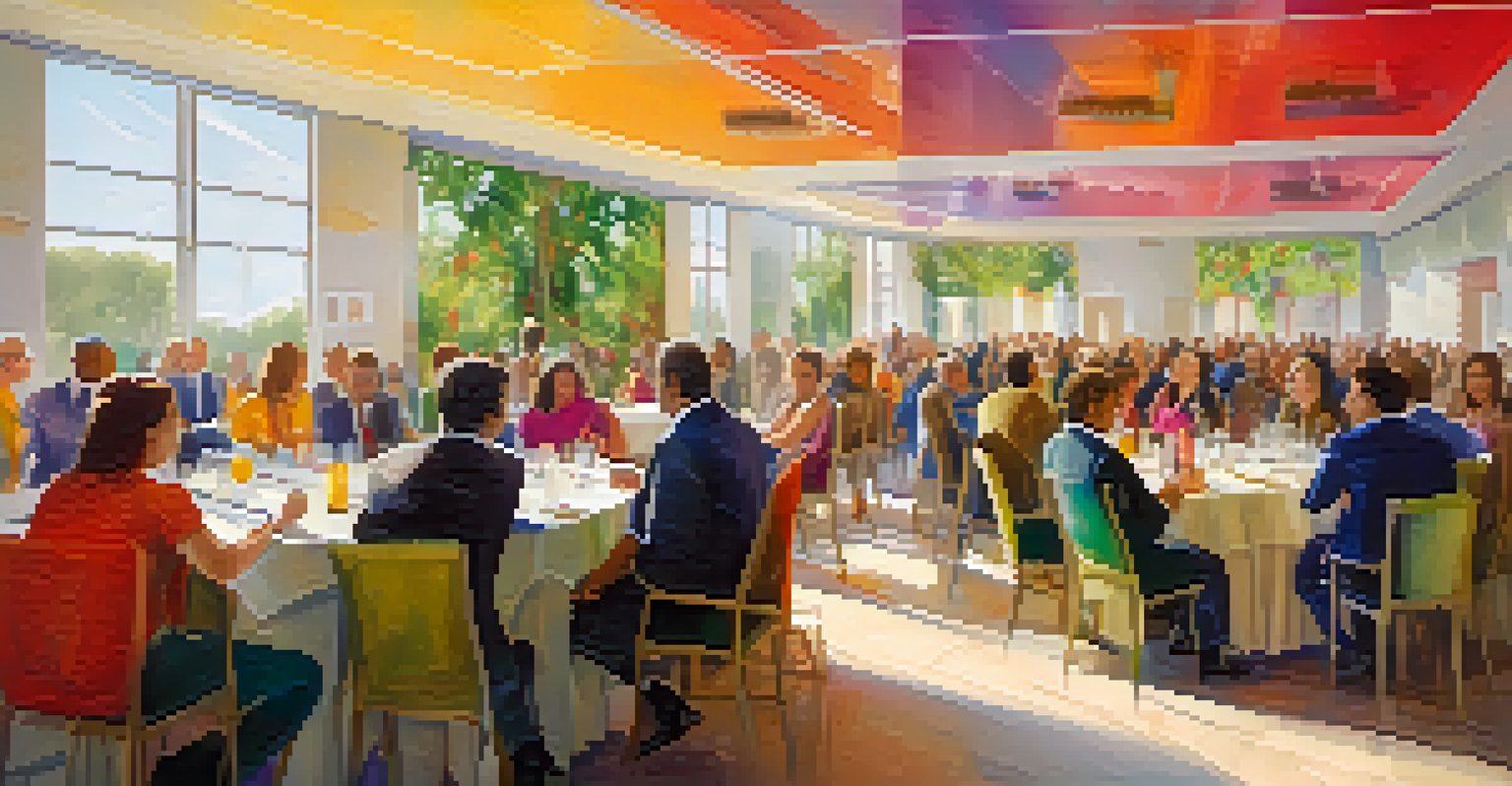Event Flow: Ensuring a Seamless Experience for Guests

Understanding Event Flow and Its Importance
Event flow refers to the seamless progression of activities during an event, ensuring everything runs smoothly. When planned well, it helps guests engage fully and enjoy the experience without feeling lost or overwhelmed. Think of it like the rhythm of a song; a good flow keeps everyone in tune and on track.
Events are about the journey, not the destination. The best moments often arise from well-planned transitions and thoughtful engagement.
An effective event flow takes into account the layout, timing, and guest interactions, ensuring every element complements the others. For instance, transitioning from a keynote speech to a networking session should feel natural rather than abrupt. This connection makes guests feel more comfortable and encourages meaningful interactions.
Ultimately, a well-orchestrated event flow can enhance guest satisfaction, leading to positive word-of-mouth and repeat attendance. Just like a well-designed journey, if the path is clear and enjoyable, guests are likely to remember and cherish the experience.
Mapping Out the Guest Journey
To create a seamless event flow, start by mapping out the guest journey from arrival to departure. This involves visualizing every interaction and transition, ensuring that each step feels intuitive and engaging. It’s similar to planning a road trip where you plot out stops to ensure a smooth ride.

Consider each touchpoint, such as registration, seating, and refreshments, and think about how guests will navigate these areas. For example, having clearly marked signs can help guide guests to the right locations, avoiding confusion and frustration. Additionally, a friendly staff presence can enhance this journey, providing assistance when needed.
Importance of Event Flow
A well-planned event flow enhances guest engagement and satisfaction, ensuring a smooth and enjoyable experience.
By anticipating potential bottlenecks and addressing them in advance, you can significantly improve the overall experience. Just as a well-planned travel itinerary can lead to a memorable trip, a carefully mapped guest journey can make an event truly unforgettable.
Engagement Through Thoughtful Timing
Timing is crucial in maintaining a smooth event flow and ensuring guest engagement. Carefully scheduled activities can prevent overwhelming guests with too much information or too little interaction. For instance, alternating between presentations and interactive sessions can keep energy levels high and attention focused.
The success of an event is determined by the quality of its flow and the connections made along the way.
Consider the pacing of your program; too many back-to-back sessions can lead to fatigue. Incorporating breaks allows guests to recharge, socialize, and process what they’ve learned. This is akin to a good workout plan, where rest days are essential for optimal performance.
Ultimately, thoughtful timing reflects respect for your guests’ experience. A well-paced event not only keeps guests engaged but also fosters a sense of community and connection, making the event more enjoyable for everyone.
Creating Comfortable Spaces for Guests
Physical space has a significant impact on event flow, influencing how guests interact and engage. Comfortable seating, adequate spacing, and accessible layouts can enhance the overall experience. Imagine attending an event where you’re crammed into a small area; discomfort can detract from even the best content.
Ensure that different zones are clearly defined, such as areas for networking, dining, and relaxation. This allows guests to choose their level of engagement, whether they want to mingle or take a moment to recharge. Providing cozy seating options can encourage conversations and connections.
Mapping the Guest Journey
Visualizing the guest journey helps create intuitive transitions and interactions, making the event more memorable.
By thoughtfully designing your event space, you create an inviting atmosphere that promotes positive interactions. Just as a warm and welcoming home can make guests feel at ease, an inviting event space can significantly enhance the experience.
Incorporating Technology for a Smooth Experience
In today’s digital age, incorporating technology can significantly streamline event flow. Tools like mobile apps for schedules, maps, and networking features can empower guests to navigate the event with ease. Think of it as having a personal tour guide in your pocket, providing real-time information.
Additionally, technology can facilitate smoother check-ins and registrations, reducing wait times and enhancing guest satisfaction. For instance, QR codes can expedite entry, allowing guests to access the event quickly. This efficiency mirrors how online shopping has transformed purchasing experiences.
However, it’s essential to ensure that technology is user-friendly and accessible for all guests. Providing tech support on-site can alleviate concerns and enhance confidence in using digital tools. When technology complements the event rather than complicates it, it adds a layer of convenience that guests will appreciate.
Feedback: The Key to Continuous Improvement
After the event, gathering feedback is crucial for understanding guest experiences and areas for improvement. Surveys, interviews, or informal conversations can provide valuable insights into what worked well and what could be enhanced. This feedback loop is essential for refining future events, creating a cycle of continuous improvement.
Encouraging guests to share their thoughts shows that their opinions are valued, fostering a sense of community and connection. It’s much like having a friend who genuinely wants to know how you felt about a shared experience; their input can lead to better future outings.
Role of Staff in Events
Well-trained staff are crucial in supporting guests and enhancing the overall atmosphere, contributing to a successful event.
Analyzing this feedback allows you to identify trends and make informed adjustments for future events. By being responsive to guest needs, you’re not only improving the experience but also building a loyal audience that feels heard and appreciated.
The Role of Staff in Enhancing Event Flow
The effectiveness of your event flow often hinges on the staff present. Well-trained, friendly staff can make a world of difference by providing guidance and support to guests. Think of them as the friendly faces at a restaurant, ensuring that everyone feels welcomed and attended to.
Staff should be equipped with the knowledge and tools to assist guests seamlessly throughout the event. This includes being proactive in addressing issues and providing information when needed. Just like a good team of hosts at a party, their attentiveness can enhance the overall atmosphere.

Ultimately, investing in staff training and support will pay off in terms of guest satisfaction. A dedicated team not only improves event flow but also creates an environment where guests feel comfortable and engaged, leading to a memorable experience.